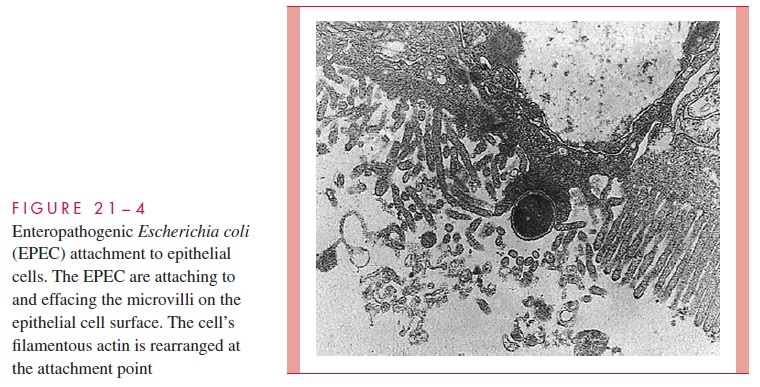Chapter: Medical Microbiology: An Introduction to Infectious Diseases: Enterobacteriaceae
Enteropathogenic E. coli (EPEC)
ENTEROPATHOGENIC E. coli (EPEC)
Epidemiology
EPEC strains were first identified as the cause of explosive outbreaks of diarrhea in hospital nurseries in the United States and Great Britain during the 1950s. The disease seems to have disappeared in industrialized nations, although it may be underestimated due to the difficulty of diagnosis. In developing countries throughout the world, EPEC account for up to 20% of diarrhea in bottle-fed infants younger than 1 year of age. The reservoir is in-fant cases and adult carriers with transmission by the fecal – oral route. Nursery outbreaks demonstrate the importance of spread by fomites, which suggests that the infecting dose for infants is low. Documented adult cases have usually been in circumstances where the number of organisms ingested was very large.
Pathogenesis
EPEC initially attach to enterocytes using pili of the BFP type to form clustered micro-colonies on the enterocyte cell surface. The lesion then progresses with effacement of the microvilli and changes in the cell morphology including the production of dramatic “pedestals” with the EPEC bacterium at their apex. The combination of these actions is called the attachment and effacing (A/E) lesion (Fig 21 – 4). The many steps involved in the formation of the A/E lesion are genetically controlled in a PAI, which includes the genes for the major attachment protein, intimin, and a contact secretion system. The secretion system injects at least five E. colisecretion proteins (Esps) into the host cell cytoplasm including, remarkably, the receptor for intimin. The other E. coli secretion proteins perturb intracellular signal transduction pathways, one effect of which is the induction of modifications in enterocyte cytoskeleton proteins (actin, talin). The cytoskeleton accumulates beneath the attached bacteria to form the pedestals and com-plete the A/E lesion. Exactly how this leads to diarrhea is not known, but the change from the normal microvillus border to the A/E must disrupt intestinal absorptive functions.

Immunity
In endemic areas, EPEC can be isolated often from the stool of asymptomatic adults, but unlike ETEC, these strains do not seem to cause traveler’s diarrhea in individuals new to the area. This casts doubt on whether adults have acquired immunity or resistance based on physiologic factors.
Related Topics